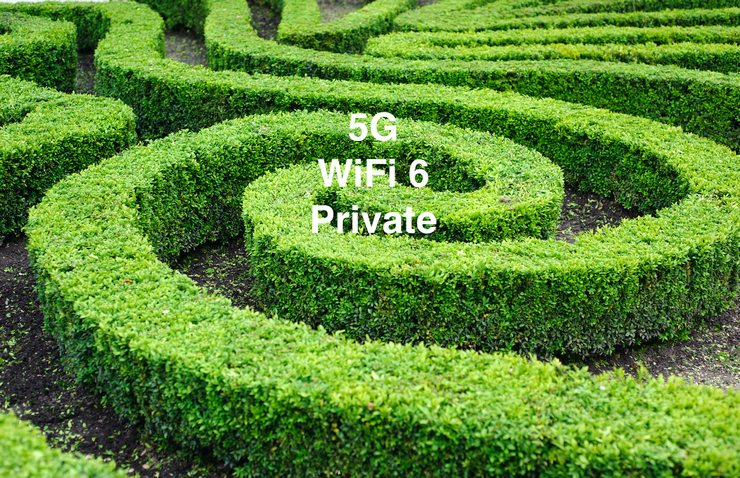The Wireless Toolkit Has More Options Than Ever and Thatís a Really Good Thing!

The wireless toolkit is undergoing a transformation that is both evolutionary and revolutionary in response to the requirement for intelligent connectivity to achieve intelligent building outcomes which includes occupant experience, operational efficiency, data insights. As a result, IT Leaders can no longer rely solely upon WiFi to connect the tens of thousands of sensors and the many devices and services inside buildings. Nor is it pragmatic to continue siloed wireless technology planning. Instead, a heterogenous approach is needed.
Arie Barendrecht, the founder and CEO of WiredScore Ė a rating system for a buildingís connectivity Ė observes, "Itís easy to believe at this point that connectivity is the lifeblood of all modern businesses... The key thing to realize is almost every important thing we do at work, every application we use, is on connectivity." Increasingly, connectivity is wireless.
Thatís great news, because next-generation wireless technologies and solutions including 5G, WiFi 6, CBRS (Citizens Broadband Radio Service) among others are poised to not only enable many of the PropTech trends Jim Young writes about in this Realcomm Advisory but, more importantly, spawn new applications thanks to new capabilities.
However, more options often leads to a maze of complexity, especially when multiple tools may offer seemingly similar benefits such as "performance." Therefore, itís tempting to fall into the "or" trap when it comes to network planning instead of embracing an "and" strategic outlook. Which is akin to the longstanding Beatles and Stones debate: why choose just one?
The following showcases use cases and applications for leading emerging wireless tools, offers guidance on rollout and timelines, and recommends what IT Leaders should be doing to prepare. Lastly, we offer a best practices planning checklist.
5G
None of the emerging wireless technologies combine as much hype, skepticism and game-changing potential as 5G, which is the fifth-generation cellular protocol defined by 3GPP, the de-facto standards organization for mobile telephony. Unlike previous generations (including the current 4G network) which were characterized exclusively by incremental performance, 5G is multi-dimensional. Not only does 5G provide an enormous pipe for enhanced mobile broadband, it also delivers ultra-reliable low latency for instant response action and supports massive multiple machine-type communication to enable an enormous number of simultaneous connections to the network.
5G capabilities will be leveraged for enhanced fan experience at sports and entertainment venues. It will connect sensors, monitors and meters throughout buildings, campuses and cities. It will elevate healthcare through remote robotic surgery and patient monitoring. Engineering firms will apply 5G for virtual reality and tactile internet capabilities, while immersive learning will improve education. Lastly, 5G will play a key role in Industry 4.0 smart factories.
Although mobile operators are aggressively rolling out the 5G macro network, the indoor environment historically trails the outdoor build-out by several years. Similarly, available spectrum and other regulatory concerns inform certain network capabilities and application use cases will emerge sooner than others. As building owners and operators await a more widespread deployment of 5G, they should not put on hold current cellular enhancement initiatives during which additional infrastructure such as fiber can be readied to support future 5G components or overlays.
WiFi 6
Wireless used to be pretty simple for buildings: you deployed WiFi. As a result, IT Leaders have nearly 20 years of familiarity with WiFi. Marketed as WiFi 6 as opposed to the IEEE standard, 802.11ax, the newest generation is focused on high efficiency wireless which exhibits certain advancements not unlike 5G including higher data rates, increased capacity, and improved performance in environments where there are many connected devices. In addition, it provides better power efficiency and interoperability. Significantly, WiFi 6 seeks to address a well-understood vulnerability Ė security Ė through the addition of government-grade WPA3 security.
WiFi will continue to be a workhorse throughout the built world, supporting a multitude of user devices such as laptops and smartphones, appliances including printers and video monitors, and IoT sensors. In addition, WiFi 6 will enable specialty applications within sectors like Ė say Ė healthcare where patient monitoring, asset tracking and staff communications are wireless.
WiFi 6 routers are already available, and devices such as laptops and smartphones are increasingly hitting the market. Given familiarity with deploying and supporting the technology, the take-rate will likely be high and fast because of low risk thanks to backward compatibility. WiFi is clearly a staple of wireless connectivity, however, IT Leaders should nevertheless consider a heterogenous toolkit approach to ensure performance and integrity for business-critical applications and services.
OnGo / CBRS / Private LTE
To keep things simple, weíll refer to these terms as "Private Cellular." Unlike 5G and WiFi 6, Private Cellular is not a technology standard but, rather, spectrum Ė specifically, 150 MHz of spectrum which constitutes a massive block that far exceeds that which is owned by mobile operators. Whatís similarly notable is Private Cellular is the first attempt by the Federal Communications Commission (FCC) to share spectrum for federal and non-federal use. It cannot be understated how revolutionary this is because it democratizes access to cellular spectrum which, until now, was off-limits to most stakeholders including building owners. Now, nearly any building can deploy a Private Cellular network. Thatís why the block of spectrum is often referred to as the "Innovation Band."
In what has become a recurring theme among the next-generation wireless toolkit, Private Cellular delivers technology benefits of performance, reliability and security. In addition, it provides compelling business-oriented value propositions including CAPEX and OPEX ownership models. Private Networks will be used to support mission- and business-critical services that exceed the capabilities of WiFi. Because reach and capacity extends beyond that of WiFi, Private Networks are ideal for supporting applications such as high-definition security cameras, and for providing connectivity where fiber runs are physically or financially unfeasible. Private Cellular capabilities inform they will play a key role in industrial sectors including factories, warehouses and logistics centers as well as mining and oil and gas. Lastly, Private Cellular may eventually emerge as a solution to provide multi-operator cellular connectivity inside buildings to support BYOD iniatives by removing the necessity of a carrier-initiated signal source.
The FCC authorized the Full Commercial Deployment (FCD) of Private Cellular recently in late January. Prior to that, pilots and Initial Commercial Deployments (ICD) occurred throughout 2019. An extensive ecosystem exists, and there is a growing portfolio of available devices that can connect directly or connect existing devices via gateways to Private Cellular networks to support myriad applications. Given its nascency, Private Cellular will build momentum in the coming years. Nonetheless, IT Leaders would be remiss to not actively plan and begin to implement these networks as part of a heterogenous network strategy starting now.
Best Practices
Because every building owner and operator has unique goals and requirements and, of course, every building is different, there is no "silver bullet" solution or cookie-cutter approach for wireless network planning. Nonetheless, there exist best practices:
(1) Be proactive, not reactive.
(2) Consider short-term (12-24 months), mid-term (3-5 years) and long-term (7-10 years) scenarios.
(3) Establish SMART Goals (where S = specific; M = measurable; A = attainable; R = relevant; and T = time-based).
(4) Capture business and technical requirements across functional area stakeholders.
(5) Identify financial monetization and federal / state / municipal compliance guidelines.
(6) Embrace a heterogenous network approach and adopt the best tools for the job.
(7) Plan for the unexpected by designing for capacity and infrastructure upgrade contingencies.
(8) Donít go it alone: engage trusted resources early and often.
This Week’s Sponsor
Intelligent Buildings begin with Intelligent Wireless Connectivity. RF Connect ensures business-critical applications, BYOD initiatives, occupant connectivity and public-safety communications requirements are met. We do this by designing, deploying, managing and operating wireless communication networks indoors and outdoors. Our scope encompasses technology solutions, capital funding, and turnkey managed services to address the wireless imperative for today and the future.
Read Next
 4/18/2024
4/18/2024
Best Practices for Managing Lease Renewals When your commercial leases come up for renewal, itís a great opportunity to assess your real estate portfolio, consider the value of current leases and possibly negotiate better terms.
 4/11/2024
4/11/2024
3 Reasons to Incorporate AI Into Your Talent Retention Strategy Introducing new technology into the workplace is often met with suspicion.
 4/4/2024
4/4/2024
Operational Technology (OT) Data Data has been a cornerstone of business since the early days of computing in the 1960s.
 3/28/2024
3/28/2024
The Tech-Forward Response to Rising CRE Cap Rates is Also People-First Cap rates on commercial real estate have been rising for five consecutive quarters, leading to an estimated 20% drop in value for many property types, according to CBREís latest U.S. Real Estate Market Outlook.






.jpg)


